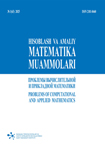Numerical modeling of the geofiltration process on irrigated lands taking into account physical factors
DOI:
https://doi.org/10.71310/pcam.1_63.2025.02Keywords:
groundwater level, filtration rate, temperature, concentration, saturation, irrigation water, level functionAbstract
The article analyzes the theoretical and practical aspects of the mathematical model for forecasting groundwater movement and level based on the studied literature. Using this model allows for efficient management of irrigation systems and conservation of water resources. An improved mathematical model based on Darcy’s law and convectiondiffusion equations for determining groundwater movement and level for areas for repeated crops is presented. The model allows for determining the velocity and concentration of groundwater, taking into account the processes of water convection and diffusion. Furthermore, the model’s effectiveness is enhanced by utilizing factors such as water salinity level, temperature, and soil saturation when calculating the permeability coefficient.
References
Ravshanov N., Daliev S., Abdullaev Z., Khafizov O. Ground and confined underground waters and their salt content // IOP Conf. Ser.: Mater. Sci. Eng. – 2020. – Vol. 896. – DOI: 10.1088/1757-899X/896/1/012047.
Ravshanov N, Daliev S. Non-linear mathematical model to predict the changes in underground water level and salt concentration. // Phys.: Conf. Ser.: – 2020. – Vol. 1441. –DOI 10.1088/1742-6596/1441/1/012163
Ravshanov N., Zagrebina S.A., Daliev Sh.K. Numerical simulation of unsteady underground water filtration in a porous medium . // Проблемы вычислительной и прикладной математики. – 2019. – No. 4(22). – C. 12-30.
Ravshanov N., Murodullaev B.T., Boborakhimov B.I. Numerical modeling of groundwater filtration processes in irrigation areas. // Problems of Computational and Applied Mathematics. – 2024. – No. 3(57). – P. 47–56.
Khabibullaev I., Murodullaev B.T., Haqnazarova D.O. Numerical modeling of groundwater filtration in irrigated areas. // Problems of Computational and Applied Mathematics. – 2023. – No. 5(52). – P. 44–55.
Sodiqov R.O., Yangiboyev X.H. Takroriy ekin yer uchun ham, dehqon uchun ham foydalidir. // Scientific Impulse. – 2023. – Vol. 3, – No. 100, – P. 1524–1527. – https://nauchniyimpuls.ru/index.php/ni/article/view/8302
Боборахимов Б., Муродуллаев Б., Журабоева О., Хакназарова Д. Математическое и численное моделирование процесса геофильтрации орошаемых сельскохозяйственных земель с учетом физических характеристик. // Международный Журнал Теоретических и Прикладных Вопросов Цифровых Технологий. – 2024. – No. 3. – Vol. 7, – P. 45–52. doi.org/10.62132/ijdt.v7i3.195
Carsel R.F., Parrish R.S. Developing joint probability distributions of soil water retention characteristics. // Water Resour Res. – 1988. – Vol. 24, – No. 5, – P. 755–769.
Domenico P.A., Schwartz F.W., Physical and chemical hydrogeology. // – 1997.
Harbaugh A.W., Banta E.R., Hill M.C., McDonald M.G. Geological survey modular groundwater model-user guide to modularization concepts and the ground-water flow process. // US Geological Survey Open-File Report. – 2000. https://doi.org/10.3133/ofr200092
Cleveland T.G. 2020. Applied Contaminant Transport Modeling-Theory and Practice. // Transactions American Geophysical Union. – 1996. – Vol. 77. – No. 48, – P. 479–479. DOI: 10.1029/96EO00320.
Kinzelbach W. Groundwater modelling An introduction with sample programs in BASIC. // Elsevier. – 1986.
Полубаринова-Кочина П.Я. Теория движения грунтовых вод . // Наука. – 1977 – 664 c.
Черепанский М.М. Региональные гидрогеологические прогнозы влияния отбора подземных вод на речной сток. // – 2006. – 395 c.
Орехов В.В., Хохотва С.Н., Алексеев Г.В. Математическое моделирование изменения гидрогеологического режима территории в результате строительства подземного комплекса. // Вестник МГСУ. – 2016. – Vol. 4, – C. 52–61.





